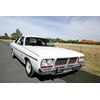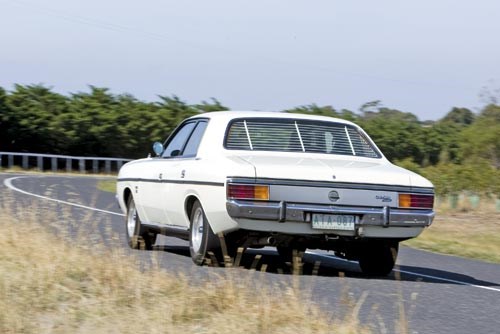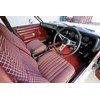Chrysler CM Valiant (1978-81) Buyers Guide
 Chrysler CM Valiant Buyer's Guide
Chrysler CM Valiant Buyer's Guide

 Chrysler CM Valiant Buyer's Guide
Chrysler CM Valiant Buyer's Guide

 Chrysler CM Valiant Buyer's Guide
Chrysler CM Valiant Buyer's Guide

 Chrysler CM Valiant Buyer's Guide
Chrysler CM Valiant Buyer's Guide


|
|
Chrysler CM Valiant Buyer's Guide
|

|
|
Chrysler CM Valiant Buyer's Guide
|

|
|
Chrysler CM Valiant Buyer's Guide
|

|
|
Chrysler CM Valiant Buyer's Guide
|
Chrysler CM Valiant - These big Chryslers saw the end of local production, and are becoming increasingly collectable because of that.

|
|
Chrysler CM Valiant (1978-81) Buyer's Guide
|
Chrysler CM Valiant (1978-81)
Despite having the best engine in Australia's automotive mainstream, 1970s Valiants were seen as bloated and thirsty, with wafty handling, mediocre brakes and crook seats. The shape hadn't changed since 1971 and sticking a new grille on the old body every couple of years wasn't fooling anybody.
Holden and Ford were in a similar boat, but they at least were about to greet the 1980s with dramatic transformations of their mainstream models. For Chrysler to remain competitive in the big-car game there was a lot to fix and minimal money or desire to do it - especially in a company smitten by the success of its new Sigma.
However, the eight-year-old design had well and truly recouped its tooling costs and every Valiant sold was still turning a tidy profit.
Viewed through showroom windows in November 1978, the revamped CM Valiants were hard to distinguish from the CLs they were replacing. Chrysler's advertising pretty much ignored the superficial changes, instead hammering home the cars' improved levels of standard equipment and a 25 percent boost to fuel economy.
Having already introduced Electronic Lean Burn (ELB) engine management to its V8, Chrysler also adapted the technology to the CM's six-cylinder engines. ELB was a 'Spark Control System' that used computerised analysis to optimise economy while easily meeting the ADR27A emission levels adopted in 1976.
Four CM models were available - the base-model Valiant and Regal, the lavishly-equipped Regal SE and a new sporty version that carried 'GLX' badging. The utility and slow-selling Drifter van were both gone, as was the Charger. Engines were 4.0 and 4.3-litre six-cylinders with up to 122kW. The 5.2-litre V8 remained optional until the middle of 1980 but was rarely seen.
Good news for Valiant owners with hankerings for a four-door Charger was the GLX. With four-on-the-floor or three-speed automatic, this 4.3-litre up-spec version of the base model came with alloy wheels, a tachometer, roof and floor consoles, cloth-insert seats and a sports steering wheel. However, the $8148 GLX was only $400 cheaper than a 4.3-litre Regal and few were sold.
Production ceased in August 1981 and the final CM off the line sold at auction some years ago for $37,000.
ON THE ROAD
Last-gasp Valiants are already 30 years old or rapidly getting there, yet remain viable as everyday transport. Yes, they're physically large, but the space they occupy on the ground translates into abundant interior space and carrying capacity.
The wagon versions are enormous inside and even with a full passenger load, will still carry a massive amount of gear on the platform behind. CM seats, even in cars with front buckets, are fairly flat and unsupportive, but shoulder room is excellent and bench seat models will genuinely accommodate six full-sized people.
Valiants typically discourage the vertically-challenged, and CMs are no different. The driver sits low, impeding vision, and it's hard to get close enough to the pedals without having the wheel in your lap. Any AFL ruckmen, though, won't feel cramped as the front seats can be shoved back a long way.
Under the bonnet and floor, the news is all good. Chrysler's in-line six-cylinder engine with hemispherical cylinder head ranks with the best power units ever built in this country. Certainly, the single-carburettor, overhead valve unit is rudimentary but you just need to look at the power extracted from 'E' prefix racing Chargers to appreciate its potential.
The smallest engine available to CM buyers was a 4.0-litre; with Regal and GLX owners getting a 4.3-litre as standard. With ELB, the larger motor was capable of 10L/100km and average consumption shouldn't get much beyond the mid-teens.
To understand how different the CM was from pre-1978 models, it's worth driving an example from both eras. Earlier cars would wander without apparent cause even on straight and smooth roads. By altering the front suspension castor settings, Chrysler instantly improved both stability and steering feedback. Wider wheels with radial tyres helped as well and even power-steered cars will do their best to let you know when the limit of front-end grip is approaching.
Road tests highlighted the CM's tendency to switch fairly smartly from tyre-scrubbing understeer to a tail-out slide; however this rarely occurs in normal motoring. Loose surfaces and corrugations will get the back end moving around, but easing back on the throttle will normally bring the car back into line. Brake locking on wet bitumen is common - wagons being more prone to the problem than sedans - so delicate use of the large pedal is essential.
Even when the linkages were new, three-speed column shifters were fairly vague and reverse could be hard to find. Second gear is a fair stretch, making the column-shift manual a chore to use in traffic.
The four-speed manual gearbox fitted to the scarce GLX cars is pretty durable and easy to use, however most Valiants of this age will have the near-unkillable Borg-Warner Type 35 automatic transmission with a column selector or console-mounted T-bar.
HOW MUCH?
After decades of being ignored by people who believed the only '70s Valiants worth owning were wearing Charger badges, the CM is enjoying significant boosts to market interest and value.
Owners who recently have been seeking $15,000 and above for these cars probably need to lower their expectations, however rare versions like our featured GLX or a Regal in outstanding condition certainly have the ability to vault the $10,000 price barrier.
Despite their age and dynamic shortcomings, Valiants remain eminently practical vehicles for recreational use or regular transport. The long, shallow boot offers plenty of space for an LPG tank and gas-equipped cars aren't substantially dearer than those of similar quality running straight petrol.
Station wagons with the rear seat lowered have the floor space of a small warehouse and are sensible for those with big families who want to also take large quantities of luggage on their annual holiday. Regal versions in good condition are available at $5000-7000, with basic 4.0-litre Valiants below $4000.
Values don't yet justify the cost of restoring a seriously worn CM and rusty examples certainly should only be considered as sources of spare parts.
I OWN ONE!
Ron Anderson's involvement with Valiants stretches back to the early 1970s and his enthusiasm for the model hasn't waned.
"I got an AP5 when I first got my licence and I bought this car in 1983 with only 40,000km on it," he said.
"Compared to earlier models, the RTS work that Chrysler did really made a difference; cutting down the body roll and making the steering feel sharper. I've added some Koni shock absorbers and that has smartened the handling up even more."
Ron's 1978-build CM is one of the extremely rare GLX versions which came standard with a four-speed manual 'box, cloth trim and seven-inch Hotwire alloy wheels. In his hands, the car has travelled a further 100,000km with only routine maintenance.
"The drivetrain and engine are original, the brakes have been relined but the discs are original and just needed a skim. Just about anything mechanical you need is available," he explains. "With the ELB working properly, they are more economical than a modern fuel injected motor of the same size."
CHECKLIST
body & Chassis
No matter how tidy and shiny a Valiant of this age looks on the outside, all of these cars must be checked underneath before you buy. Rust attacks front sub-frame and steering-box mounting points, rear spring hangers, floors and inner sills. Any vehicle with damage in more than one of these areas may be uneconomic to repair. Superficially, door skins (especially the tailgate on wagons), wheel-arches, lower mudguard edges and window surrounds are spots to check for bubbling or body filler. Make sure that the winding rear window on wagons moves easily and that the handle can be locked. Chromed parts are difficult to find in good condition (a bumper was advertised at $165) and expensive to renovate, so rusty bumpers and a dented grille will lower a vehicle's value.
Engine & Transmission
Most cars in this age range will have travelled more than 200,000km, but that's about half the potential life-span of a properly-maintained Valiant engine. Oil smoke is a sign of worn piston rings and perhaps cylinder bore damage. Oil leaks are common and usually not a major issue. Complete, rebuilt engines sell for around $4000, however good second-hand units at under $1000 will keep an average car going. Just buying the parts for a rebuild will cost close to $1500. Inspect the hose connections for signs of rust or leakage and plan on having the radiator reconditioned and the water pump (these brand new cost under $80) replaced. A car that is hard to start and performs poorly may be suffering ELB gremlins. New units are available for around $500 or reconditioned for under $400. Some owners prefer to replace them with the more basic electronic ignition from a CL.
suspension & Brakes
Front end components and bushes are easy to find and inexpensive. Rear springs can sag and suffer age-related cracks. Perished suspension rubbers will generate noise, affect steering response and ride quality. GLX owner Ron Anderson recommends high-quality shock absorbers which further reduce body roll. Front torsion bars rarely give problems but beware cars that make loud cracking sounds when driven over bumps or braked hard. Brake components are available new or easily renovated. Make sure the handbrake releases without excessive effort and will hold the car on a slope.
Interior & Electrics
The Lawson cloth trim fitted to upmarket cars suffers wrinkling and the effects of 30 years in the Australian sun. Anderson recommends lowering yourself into the seat rather than sliding across it to minimise the chance of tearing old and fragile fabric. Seat runners - especially in bench seat cars - can jam so make sure the seat moves easily and locks in place. Wagons often suffer cargo damage to the load area and replacement trim will need to be found second-hand. Reproduction carpet sets for sedans cost less than $200. Air-conditioned vehicles need to already be running CFC-free refrigerant, otherwise your outlay to replace the air-con unit or upgrade the original could exceed $2000.
SPECIFICATIONS
Chrysler CM Valiant (1978-81)
NUMBER BUILT: 16,005
BODY: all-steel, unitary construction, four-door sedan and station wagon
ENGINE: 4.0 or 4.3-litre in-line six-cylinder with overhead valves and single carburettor; 5.2-litre V8 with overhead valves and single carburettor
POWER & TORQUE: 114Kw @ 4400rpm/ 282Nm @ 2800rpm (4.0-litre)
PERFORMANCE: 0-100km/h - 11.3secs. 0-400 metres - 17.5secs (4.0-litre automatic)
TRANSMISSION: three-speed automatic; three or four-speed manual
SUSPENSION: Front - independent with torsion bars, telescopic shock absorbers and anti-roll bar. Rear - live axle with semi-elliptic springs and telescopic shock absorbers
BRAKES: disc front/ drum rear; power assisted
TYRES: ER85S/14 radial
PRICE RANGE: $500-12,500
CONTACT: Chrysler clubs in all states
Website: chryslerclub.org.au
Unique Cars magazine Value Guides
Sell your car for free right here
Get your monthly fix of news, reviews and stories on the greatest cars and minds in the automotive world.
Subscribe

.jpg)



.jpg)

.png)



